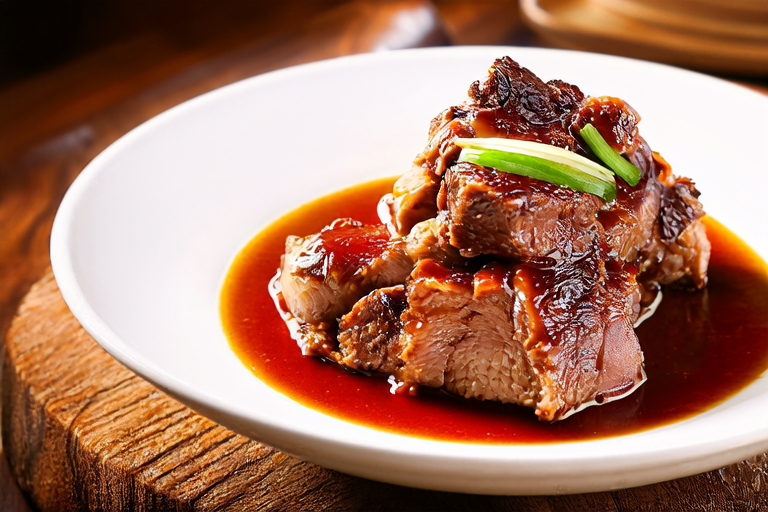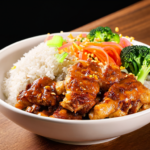- Introduction to Suzhou Style Braised Beef Shoulder
Suzhou style braised beef shoulder is a classic dish in Jiangsu cuisine, known for its rich flavor and tender texture. The dish is characterized by its deep brown color and the succulent beef that melts in your mouth. This traditional recipe has been passed down through generations and is beloved for its simplicity and elegance.
- Ingredients
- Beef shoulder, 1 kg
- Ginger slices, 3-4 pieces
- Spring onions, 3-4 pieces
- Star anise, 2-3 pieces
- Fennel seeds, 1 teaspoon
- Black pepper, 1/2 teaspoon
- Chinese rice wine, 2 tablespoons
- Dark soy sauce, 2 tablespoons
- Light soy sauce, 1 tablespoon
- Rock sugar, 2 tablespoons
- Water, as needed
- Vegetable oil, for frying
- Preparation of Ingredients
Before you start cooking, it’s essential to prepare all the ingredients thoroughly. Start by washing the beef shoulder under cold water and patting it dry with paper towels. Cut the beef into bite-sized pieces, ensuring each piece is uniform in size for even cooking. Slice the ginger and spring onions diagonally for better presentation. Measure out the spices and sauces accurately to ensure the right balance of flavors.
- Cooking Process
Step 1: Blanche the Beef
Place the beef pieces into a large pot of boiling water. Bring the water to a rolling boil, then immediately drain the beef and rinse it under cold water. This step helps remove any impurities and excess fat, ensuring the beef remains tender during the braising process.
Step 2: Fry the Beef
Heat a wok or pan over medium heat and add a small amount of vegetable oil. Once the oil is hot, add the blanched beef pieces and stir-fry them until they turn golden brown. This step not only enhances the flavor but also locks in the moisture, preventing the meat from becoming tough during the subsequent braising process.
Step 3: Prepare the Braising Sauce
In a separate bowl, mix together the dark soy sauce, light soy sauce, Chinese rice wine, rock sugar, star anise, fennel seeds, and black pepper. Ensure all the ingredients are well combined to create a harmonious blend of flavors.
Step 4: Combine and Braise
Add the fried beef back into the wok or pan along with the prepared braising sauce. Pour in enough water to cover the beef, then bring the mixture to a boil. Reduce the heat to a gentle simmer and let the beef cook slowly for about 2 hours. During this time, periodically check the water level and add more if necessary to prevent the beef from drying out.
Step 5: Final Touches
Once the beef is tender and the sauce has reduced to a thick consistency, remove the beef from the heat. Garnish with the sliced ginger and spring onions for added freshness and aroma. Allow the dish to rest for a few minutes before serving to enhance the flavors.
- Serving Suggestions
Suzhou style braised beef shoulder pairs wonderfully with steamed white rice or noodles. The rich, savory broth can be used as a dipping sauce for vegetables or dumplings. For a complete meal, consider serving it alongside a side salad or lightly stir-fried greens to balance the richness of the dish.
- Tips for Success
- Choose high-quality beef shoulder for the best results. Look for cuts with some marbling for added flavor.
- Pat the beef dry after blanching to ensure it fries evenly and develops a golden crust.
- Use a heavy-bottomed pot for braising to maintain consistent heat distribution.
- Adjust the seasoning according to your taste preferences, adding more soy sauce for saltiness or rock sugar for sweetness.
- Nutritional Information
Suzhou style braised beef shoulder is a nutrient-rich dish, providing a good source of protein, iron, and other essential nutrients. However, due to the use of soy sauce and rock sugar, it is advisable to consume it in moderation, especially for those watching their sodium intake.
- Conclusion
Suzhou style braised beef shoulder is a testament to the culinary artistry of Jiangsu cuisine. Its simple yet profound flavors make it a favorite among food enthusiasts. By following this detailed recipe, you can recreate this delightful dish in the comfort of your own kitchen and savor the authentic taste of Suzhou.


